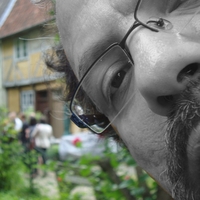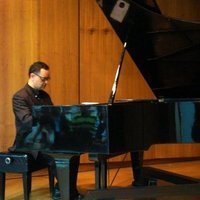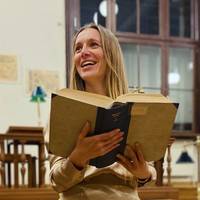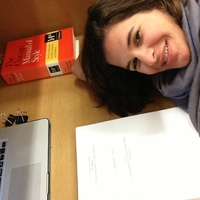
Tomasz Jeż
Related Authors
François Soyer
University of New England - Australia
Katherine Butler Schofield
King's College London
Stefan Bauer
King's College London
Ruben López-Cano
Escola Superior de Música de Catalunya
Christoph Flamm
Universität Heidelberg
Juan Francisco Sans
Universidad Central de Venezuela
Philip Fountain
Victoria University of Wellington
Francisco de Paula Souza de Mendonça Júnior
UFSM - Universidade Federal de Santa Maria
Kati (Katalin) Prajda
University of Vienna
Amanda J. Lucia
University of California, Riverside
InterestsView All (26)










Uploads
Papers by Tomasz Jeż
The operative strategies employed by composers that we have been studying clearly accorded with the narrative of Jesuit authors who advanced the concept of parodia in their textbooks on poetics — Roberto Bellarmino, Jacob Pontanus and Jacob Masen, amongst other. Like other European humanist authors, their understanding of the concept derived from Aristotle and Quintilian. It is they who made clear the purposes for which one might have recourse to these strategies and the circumstances in which one should employ such tools. Literature and music that came about in reliance on these sorts of procedures had to serve a didactic function, first and foremost. And in point of fact, the same could also be said about the cultural context of repertoire presented in this paper.
But the rites of rogation days were also performed in times of natural disasters, especially prolonged drought, during which the Litany of the Saints, associated with the procession petitioning for their intercession, was sung. The evidence for such an event is a small paper card with the prayer beseeching for rain found in a set of partbooks transmitting the score for a Litaniae de omnibus Sanctis pro diebus Rogationum. The copy of this composition comes from the Convent of the Canonesses Regular in Wrocław (PL–Wu RM 6140) and was composed by the Silesian Jesuit Joannes Faber (1599–1667). The piece is not only a unique source for the rare musical production of Jesuits at this time; it can be also examined in the context of studies on climate changes of the past.
The setting of the litany by Faber was most probably performed on the
occasion of a protracted drought that happened in 1684. Confirmation for this fact can be found in archival sources of Catholic provenance from Silesia (i. e. chronicles of Jesuit centres), but it was also predicted by prognostics and calendars printed in Protestant cirles of this region. Both types of sources provide compelling insight into the social strategies of different confessional environments, revealing both their social strategies and contrasting worldviews.
stored a rich collection of Seicento music, composed by various masters from the
north Italian cities. Among many music prints and manuscripts, one can find compositions
whose authors were the musicians belonged to the Franciscan convents
of this geographic area and active in the Saint Anthony basilica. The passive layer
of the reception are representing rare music prints of this provenance, enclosed
in the churches of Saint Bernhardin and Saint Elisabeth: Ludovico Balbi, Giulio
Belli, Amadio Freddi and Leandro Gallerano. But the music repertory composed
in Franciscan Padua inflitrated also the Protestant liturgy of this time. This process
is testified by some handwritten copies and organ intabulations of motets by
Ludovico Balbi and Costanzo Porta, and a masses by Giulio Belli and Leandro
Gallerano adopted to the cultivated in Breslau liturgical practice. They found its
place in the Protestant manuscript thanks to anthologies by Lindner, Praetorius
and Schadeus and has been adopted thanks to its universal character, across confessional
boundaries. In some cases one cas however find some correspondence
of both confessional spiritualities, which can be explained by the cultural contacts
between the Protestant churches of Breslau and the preexisting in this city rich
spiritual tradition of the Franciscan Order.
This way passed many musicians from Lusatia fluent in Silesia. From Lusatia originated cantors, organists and song composers. The opposite direction is much more compound. Many of Silesians had found their work in the music institutes of Lusatia. From Silesia came also many Lusatian instrumentalists, cantors and important in all region organ builders. Equal rich is the group of music teachers, song composers and authors of theater spectacles who staged their works in Görlitz. Last category are forming the musicians well known in both regions: as well those active in many places as well those connected with one major, but whose compositions were preserved in many local libraries. An important role in spreading of this local repertory played some more important institutions, like Görlitzer Convivium musicum.
Nonostante l’evidenzionata storicamente presenza degli compositori veneziani (p.es. Antonio Bioni), la maggioranza del repertorio accumulato nelle bibilioteche slesiane appartiene alla suola neapolitana, conservata sopratutto nei centri cattolici. Tra i più importanti ordini religiosi l’interesse per la musica neapolitana mostravano sopratutto cisterciensi e canonici regolari, poi anche francescani, domenicani e gesuiti. I manoscritti accumulati nelle loro biblioteche rivelano l’infiltrazione multidirezionale del repertorio, confermando i stretti legami tra le familie degli ordini ed anche i monasteri della stessa regola.
Tra le composizioni degli autori universalmente conosciuti, come Giovanni B. Pergolesi, Francesco Feo e Leonardo Leo, una posizione straordinaria occupa la musica di Johann Adolf Hasse, attivo negli vicini centri musicali di Sassonia e Polonia. Per l’uso liturgico sono stati adattate tante arie d’opera, composte non solo dal Divino Sassone, ma anche dagli compositori italiani: Giuseppe G.B. Bonno, Niccolò Jommelli, Leonardo Vinci e altri. La prattica del adattamento causava anche crescità delle composizioni del’uso polivalente, accompagnati dagli vari testi liturgici. Il repertorio conservato contiene sopratutto dal repertorio liturgico, antifone mariane, litanie ed altre composizioni del’uso paraliturgico ed occasionale.
The operative strategies employed by composers that we have been studying clearly accorded with the narrative of Jesuit authors who advanced the concept of parodia in their textbooks on poetics — Roberto Bellarmino, Jacob Pontanus and Jacob Masen, amongst other. Like other European humanist authors, their understanding of the concept derived from Aristotle and Quintilian. It is they who made clear the purposes for which one might have recourse to these strategies and the circumstances in which one should employ such tools. Literature and music that came about in reliance on these sorts of procedures had to serve a didactic function, first and foremost. And in point of fact, the same could also be said about the cultural context of repertoire presented in this paper.
But the rites of rogation days were also performed in times of natural disasters, especially prolonged drought, during which the Litany of the Saints, associated with the procession petitioning for their intercession, was sung. The evidence for such an event is a small paper card with the prayer beseeching for rain found in a set of partbooks transmitting the score for a Litaniae de omnibus Sanctis pro diebus Rogationum. The copy of this composition comes from the Convent of the Canonesses Regular in Wrocław (PL–Wu RM 6140) and was composed by the Silesian Jesuit Joannes Faber (1599–1667). The piece is not only a unique source for the rare musical production of Jesuits at this time; it can be also examined in the context of studies on climate changes of the past.
The setting of the litany by Faber was most probably performed on the
occasion of a protracted drought that happened in 1684. Confirmation for this fact can be found in archival sources of Catholic provenance from Silesia (i. e. chronicles of Jesuit centres), but it was also predicted by prognostics and calendars printed in Protestant cirles of this region. Both types of sources provide compelling insight into the social strategies of different confessional environments, revealing both their social strategies and contrasting worldviews.
stored a rich collection of Seicento music, composed by various masters from the
north Italian cities. Among many music prints and manuscripts, one can find compositions
whose authors were the musicians belonged to the Franciscan convents
of this geographic area and active in the Saint Anthony basilica. The passive layer
of the reception are representing rare music prints of this provenance, enclosed
in the churches of Saint Bernhardin and Saint Elisabeth: Ludovico Balbi, Giulio
Belli, Amadio Freddi and Leandro Gallerano. But the music repertory composed
in Franciscan Padua inflitrated also the Protestant liturgy of this time. This process
is testified by some handwritten copies and organ intabulations of motets by
Ludovico Balbi and Costanzo Porta, and a masses by Giulio Belli and Leandro
Gallerano adopted to the cultivated in Breslau liturgical practice. They found its
place in the Protestant manuscript thanks to anthologies by Lindner, Praetorius
and Schadeus and has been adopted thanks to its universal character, across confessional
boundaries. In some cases one cas however find some correspondence
of both confessional spiritualities, which can be explained by the cultural contacts
between the Protestant churches of Breslau and the preexisting in this city rich
spiritual tradition of the Franciscan Order.
This way passed many musicians from Lusatia fluent in Silesia. From Lusatia originated cantors, organists and song composers. The opposite direction is much more compound. Many of Silesians had found their work in the music institutes of Lusatia. From Silesia came also many Lusatian instrumentalists, cantors and important in all region organ builders. Equal rich is the group of music teachers, song composers and authors of theater spectacles who staged their works in Görlitz. Last category are forming the musicians well known in both regions: as well those active in many places as well those connected with one major, but whose compositions were preserved in many local libraries. An important role in spreading of this local repertory played some more important institutions, like Görlitzer Convivium musicum.
Nonostante l’evidenzionata storicamente presenza degli compositori veneziani (p.es. Antonio Bioni), la maggioranza del repertorio accumulato nelle bibilioteche slesiane appartiene alla suola neapolitana, conservata sopratutto nei centri cattolici. Tra i più importanti ordini religiosi l’interesse per la musica neapolitana mostravano sopratutto cisterciensi e canonici regolari, poi anche francescani, domenicani e gesuiti. I manoscritti accumulati nelle loro biblioteche rivelano l’infiltrazione multidirezionale del repertorio, confermando i stretti legami tra le familie degli ordini ed anche i monasteri della stessa regola.
Tra le composizioni degli autori universalmente conosciuti, come Giovanni B. Pergolesi, Francesco Feo e Leonardo Leo, una posizione straordinaria occupa la musica di Johann Adolf Hasse, attivo negli vicini centri musicali di Sassonia e Polonia. Per l’uso liturgico sono stati adattate tante arie d’opera, composte non solo dal Divino Sassone, ma anche dagli compositori italiani: Giuseppe G.B. Bonno, Niccolò Jommelli, Leonardo Vinci e altri. La prattica del adattamento causava anche crescità delle composizioni del’uso polivalente, accompagnati dagli vari testi liturgici. Il repertorio conservato contiene sopratutto dal repertorio liturgico, antifone mariane, litanie ed altre composizioni del’uso paraliturgico ed occasionale.
The complete critical edition can be downloaded here (free):
http://fontesmusicae.pl/wp-content/uploads/2017/04/Kretzmer-1.pdf